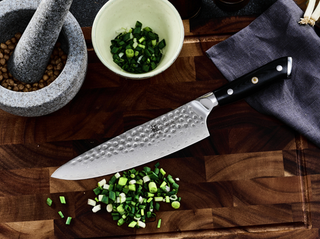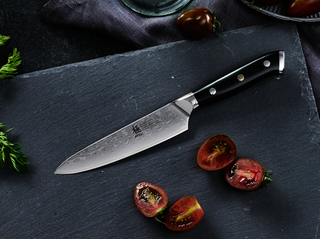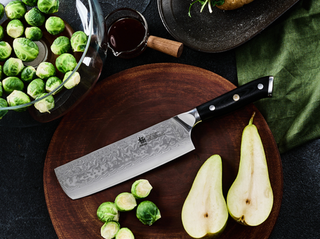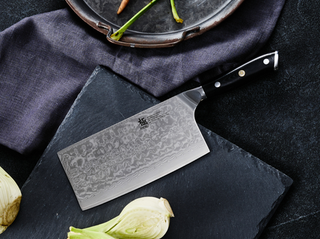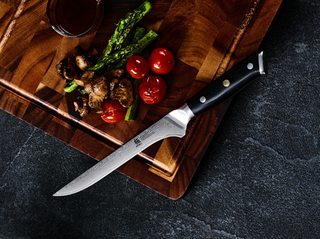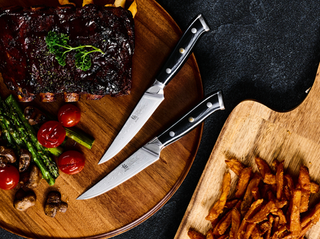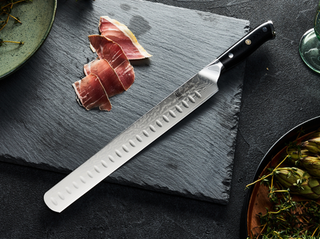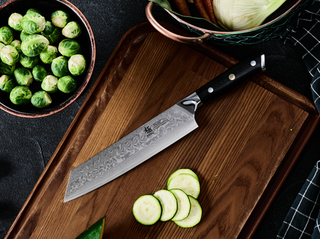The first and most important step to deciding how to cut vegetables is to consider what you intend to cook and what the vegetables need to look like.
The truth is, there is no single best way to cut or chop up vegetables. In fact, there are about five different ways to cut vegetables to choose from, which yield different results in terms of look, taste, and cooking requirements.
For soups, for example, you want bigger vegetable pieces, so you go for chopping. For spring rolls, you’d want fine strips, so you must use the julienne cut. Then there are also slice cuts, mince cuts, and dice cuts, which give you different textures, cooking times, and presentations.
So, the question really should be how to cut vegetables in a way that is most appropriate for what you are cooking.

How to Cut Vegetables: 5 Cuts To Choose From
Again, there are about five main ways you can cut your vegetables: chopping, dicing, slicing, julienning, or mincing. Each of these vegetable cutting techniques is unique and has its purpose, and choosing the right one makes prep easier and your dish more successful.
1. Chopping: For Large Vegetable Cuts
If you are cooking a dish where the vegetable pieces don't really need to look nice, trim, and proper, then chopping is the best way to cut vegetables. Chopping is quick, practical, and gets vegetables into bite-sized chunks fast. Chopped vegetables are used in soups, stews, or rustic salads.
2. Dicing: For Uniform Vegetable Cuts
If you are cooking a dish that requires the vegetable pieces to appear in uniform cubes, then dicing is the best way to cut your vegetables. Dicing vegetables takes a little more time and requires more precision, but it results in uniform cubes and a neat appearance, like in salsas, curries, or fried rice.
Explore the differences between chopping and dicing in greater detail.
3. Slicing: For Thin Flat Vegetable Cuts
If you want flat, thin vegetable pieces (for sandwiches or stir-fry, for example), then slicing is the best way to cut your vegetables. Sliced vegetables cook evenly and are easy to layer.
4. Julienne Cut: For Matchstick Vegetable Cuts
If you want long, matchstick-style strips for coleslaw or spring rolls, go for julienne cut. This cut adds visual appeal and ensures quick cooking. If you are slicing onions for fajitas, for example, the julienne cut is precisely what you need.
5. Mincing: For Tiny Vegetable Pieces
Mincing is the best way to cut your vegetables when you want tiny pieces that blend perfectly into your sauce, dressing, or marinades: it is ideal for garlic, onions, or herbs.
The good news, if you are into sauces and marinades, is that mincing is easy to learn, and the technique is very versatile, especially for preparing crucial ingredients (like minced garlic) or even chicken and soft meats.

How To Cut Vegetables For Common Dishes (Kabobs, Hibachi, Stir-Fry, etc)
Once you have established what you want to cook, it's a lot easier to figure out how to cut the vegetables. Here’s a quick look at the cuts that suit popular dishes and cooking styles:
| Dish/Use | How to Cut Vegetables | Why |
| Kabobs | Chop | Kabobs need larger, sturdy veggie pieces that will hold onto the skewer and cook evenly over the heat. |
| Hibachi | Dice or medium chop | Hibachi needs even vegetable cubes that will cook fast on the hot griddle without burning. |
| Stir fry | Thin slices or julienne | Stir-fry needs small, even pieces that will cook quickly. |
| Matchsticks | Julienne | Classic matchstick cut results in long, thin vegetable strips |
| Fajitas | Slice (strips) | The onions and peppers need to be cut into long strips for easy wrapping. |
| Skewers | chop | Similar to kabobs: vegetable pieces need to be sturdy enough for piercing and grilling. |
| Spring rolls | Julienne | Spring rolls require thin strips that fit neatly in the roll and add crunch. |
| Sushi | Thin slices | Vegetables like cucumber and avocado need to be flat and uniform for rolling. |
| Grilling | Chop | Grilling requires larger cuts to avoid burning/falling through grates. |
| Thai curry | Small dice or thin slices | Dicing helps the veggies cook evenly and absorb flavor into the sauce. |
Pro Tip for Cutting Vegetables:
- For larger chunks, chop.
- For fast cooking, go for smaller dice or slices.
- When you need to wrap or roll for slice cuts or julienne cuts.

Best Knives For Cutting Vegetables
Different ways of cutting vegetables demand different types of knives. A chef's knife, for example, is great for chopping vegetables, but may be too cumbersome for slicing. The opposite goes for a pairing knife, which is smaller, sleek, and ideal for slicing, but not ideal for chopping vegetables.
If you want your vegetables to be cut in a manner that is consistent, easier, and safer, you will need the right vegetable cutting knife: one whose size, blade, and design best match the cutting method you are using.
The good news is, you really do not need all the various cutting knives for vegetables: while there are many specialty vegetable cutting knives, most cooks only need a few essentials:
- Chef’s knives are the most versatile knives for chopping vegetables. They are great for chopping, dicing, and slicing larger vegetables. Consider this 8" Gyuto Chef Knife, which is made of VG10 Damascus Steel.
- Santoku or Nakiri. A santoku or nakiri knife is the best knife for cutting vegetables when you need precise, clean cuts, especially for thin slices or julienne. There is much debate on the topic of santoku vs nakiri knives, but either will do when it comes to cutting vegetables into thin slices.
- Utility or Paring knife. Utility knives and pairing knives are the best options for cutting vegetables for smaller, delicate vegetable cutting jobs like trimming, mincing, or prepping garnishes.
- Specialty knife(Yanagiba or sushi knife). Yanagiba knives are best for cutting vegetables only if you regularly prepare sushi and want paper-thin, clean slices.
For most kitchens, a chef’s knife, a Santoku/Nakiri, and a paring knife cover nearly every vegetable cutting task.

Best Vegetable Cutting Knives for Popular Meals
| Dish/Use | Best Knife | Why |
| Kabobs | Chef’s knife | A chef's knife has a versatile blade for cutting through firm veggies into big pieces. |
| Hibachi | Chef’s knife or Santoku | Both chef’s knives and santoku knives excel at fast, repetitive chopping and dicing. |
| Stir fry | Santoku or Nakiri | The flat blade makes it easy to produce thin, even vegetable slices. Santoku knives are especially good for precision. |
| Matchsticks | Utility knife or Nakiri | The smaller blade of a utility or nakiri knife helps control thin, uniform cuts. |
| Fajitas | Chef’s knife | Long blade handles peppers and onions smoothly in one pass. |
| Skewers | Chef’s knife | Same as kabobs, chefs’ knives work for skewers: they are sturdy and efficient for cutting dense veggies. |
| Spring rolls | Utility knife or Paring knife | Smaller knives, like pairing and utility knives, give precision for fine, thin strips. |
| Sushi | Yanagiba (sushi knife) or Chef’s knife | Yanagiba knives excel at long, clean pulls, but a chef’s knife also works as an all-rounder. |
| Grilling | Chef’s knife | Chef’s knives have enough power for harder veggies like eggplants, zucchini, or corn. |
| Thai curry | Santoku or Nakiri | Best for quick, uniform cutting into small pieces for even cooking. |
FAQs About Cutting Vegetables
1. How Do You Cut Vegetables Like a Chef?
If you want to cut vegetables like a chef, you have to master the dice cut. When most people inquire about “cutting vegetables like a chef,” they are usually thinking of the dice cut.
It is the classic professional-looking cut because it shows precision, makes food cook evenly, and gives food a polished, “top restaurant” appearance.
2. How Do You Cut Vegetables Faster?
If you need to cut vegetables faster, the best way to do so is by chopping. Unlike slicing or julienne, which would require a lot of precision and attention to detail, chopping can be done faster.
If you would like to use a technique that requires precision, but still chop your veggies faster, here are some tips:
- Using the right knife that matches the task: bigger knives for bigger pieces, smaller knives for smaller pieces
- Keeping the tip of the knife anchored and rocking the blade.
- Practice the “claw grip” so you can hold veggies safely and steadily, even as you increase cutting speed.
- Use a stable cutting board that won’t slip.

Final Thoughts on How to Cut Vegetables
The key thing to keep in mind when it comes to cutting vegetables is that there is no one method that fits all. You adopt the vegetable cutting method that is suitable for what you are cooking.
One way you can ensure that you always cut your vegetables the right way is by mastering as many knife cuts as you can. In fact, there are six essential knife cuts that even home chefs must master, and chopping, slicing, julienne, and dicing, which are regularly used for vegetables, are among these.
So, learn which cutting method fits what foods, and master as many cuts as possible so you can be versatile in your vegetable cutting. Another great way to enhance your cutting skills would be to learn these six ways to hold a knife.
